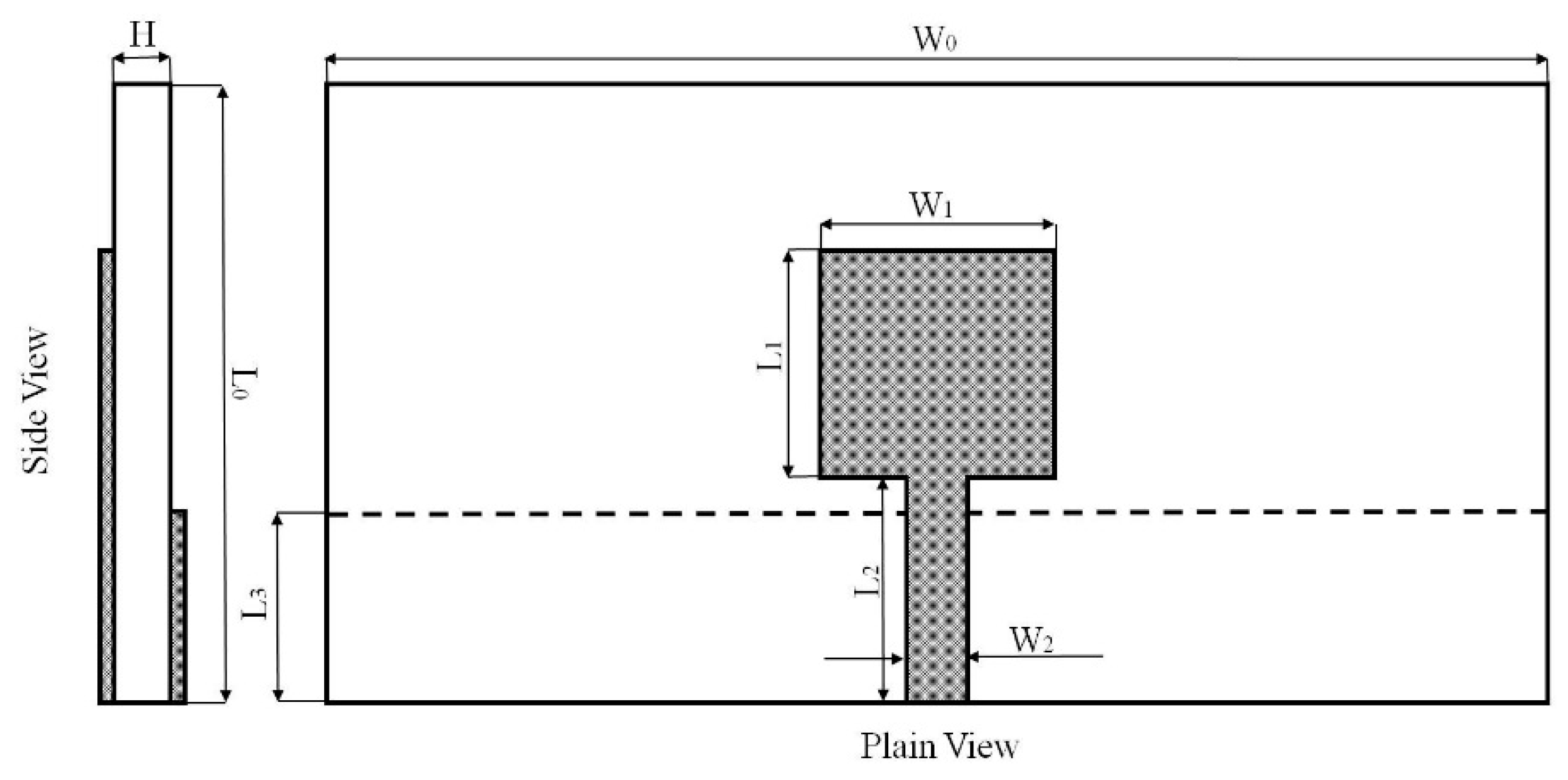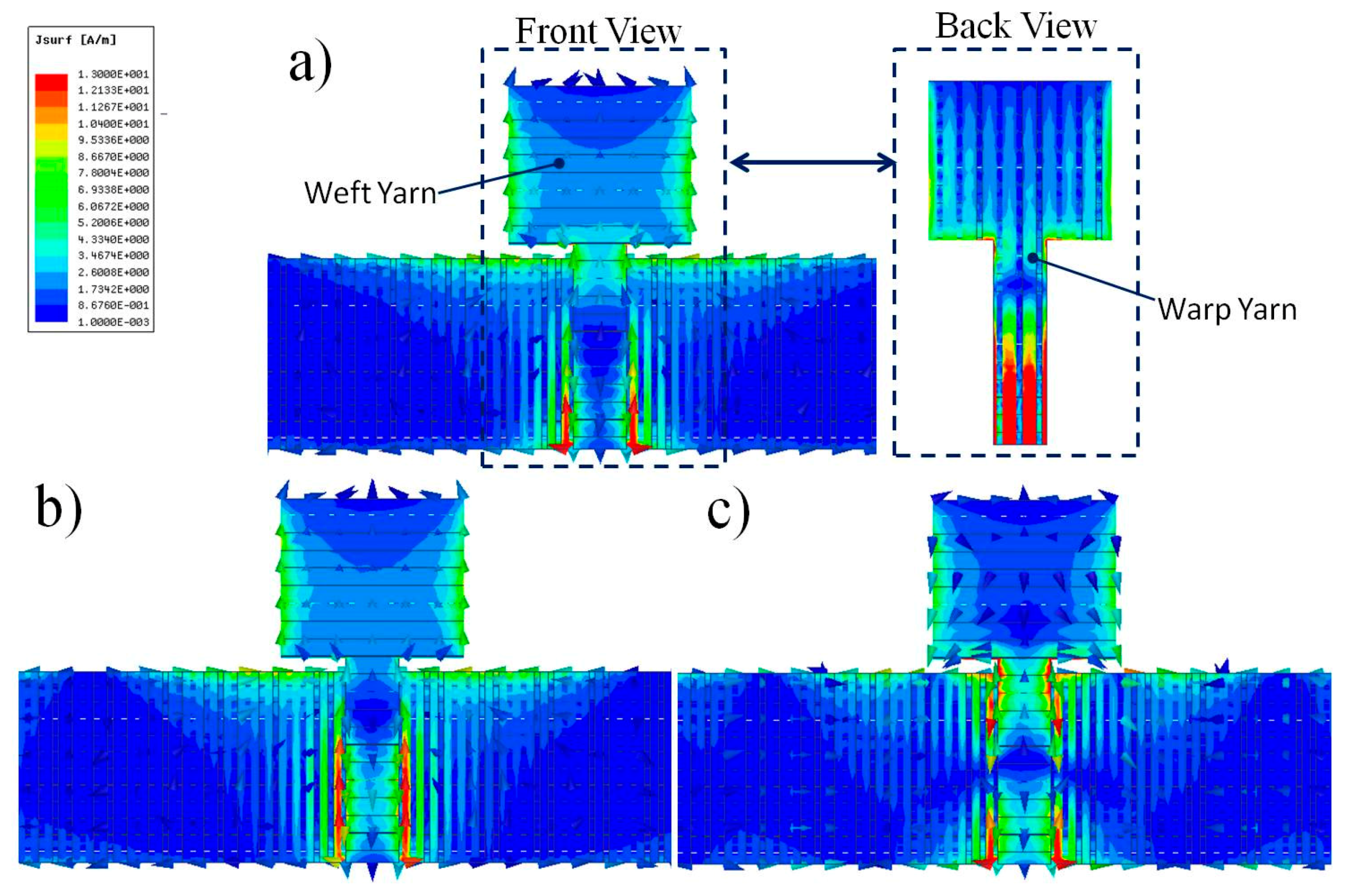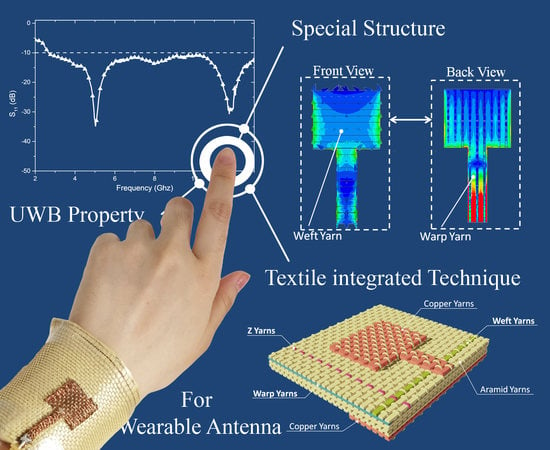Design and Electromagnetic Properties of a Conformal Ultra Wideband Antenna Integrated in Three-Dimensional Woven Fabrics
Abstract
:1. Introduction
2. Experimental
2.1. Antenna Design and Fabrication
2.2. Simulation and Measurment of Antenna Electromagnetic Properties
3. Results and Discussion
3.1. Return Loss
3.2. Radiation Pattern and Gain
3.3. Current Distribution
3.4. Bending Test
4. Conclusions
Author Contributions
Acknowledgments
Conflicts of Interest
References
- An, B.W.; Shin, J.H.; Kim, S.-Y.; Ji, S.; Park, J.; Lee, Y.; Jang, J.; Park, Y.-G.; Cho, E.; Jo, S.; et al. Smart Sensor Systems for Wearable Electronic Devices. Polymers 2017, 9, 303. [Google Scholar] [CrossRef]
- Liang, T.; Yuan, Y.J. Wearable Medical Monitoring Systems Based on Wireless Networks: A Review. IEEE Sens. J. 2016, 16, 8186–8199. [Google Scholar] [CrossRef]
- Ray, P.P.; Dash, D.; De, D. A Systematic Review of Wearable Systems for Cancer Detection: Current State and Challenges. J. Med. Syst. 2017, 41, 180. [Google Scholar] [CrossRef] [PubMed]
- Shinmoto Torres, R.L.; Visvanathan, R.; Abbott, D.; Hill, K.D.; Ranasinghe, D.C. A Battery-less and Wireless Wearable Sensor System for Identifying Bed and Chair Exits in a Pilot Trial in Hospitalized Older People. PLoS ONE 2017, 12, e0185670. [Google Scholar] [CrossRef] [PubMed]
- Zhou, Q.; Zhang, H.; Lari, Z.; Liu, Z.; El-Sheimy, N. Design and Implementation of Foot-Mounted Inertial Sensor Based Wearable Electronic Device for Game Play Application. Sensors 2016, 16, 1752. [Google Scholar] [CrossRef] [PubMed]
- Nepa, P.; Rogier, H. Wearable Antennas for Off-Body Radio Links at VHF and UHF Bands: Challenges, the state of the art, and future trends below 1 GHz. IEEE Antennas Propag. Mag. 2015, 57, 30–52. [Google Scholar] [CrossRef]
- Sharizal, F.S.; Suriani, M.S.; Kamilia, K.; Salwani, M.D.; Nor’Asnilawati, S. Review of the Current Design on Wearable Antenna in Medical Field and its Challenges. J. Teknol. 2016, 78, 111–117. [Google Scholar] [CrossRef]
- Ivšić, B.; Bonefačić, D.; Bartolić, J. Textile Antennas for On-body Sensors. In Proceedings of the Sensors Applications Symposium, Zadar, Croatia, 13–15 April 2015. [Google Scholar]
- Salvado, R.; Loss, C.; Gonçalves, R.; Pinho, P. Textile Materials for the Design of Wearable Antennas: A Survey. Sensors 2012, 12, 15841–15857. [Google Scholar] [CrossRef] [PubMed] [Green Version]
- Stoppa, M.; Chiolerio, A. Wearable Electronics and Smart Textiles: A Critical Review. Sensors 2014, 14, 11957–11992. [Google Scholar] [CrossRef] [PubMed] [Green Version]
- Weng, W.; Chen, P.; He, S.; Sun, X.; Peng, H. Smart Electronic Textiles. Angew. Chem. Int. Ed. 2016, 55, 6140–6169. [Google Scholar] [CrossRef] [PubMed]
- Yao, L.; Qiu, Y. Design and Electromagnetic Properties of Conformal Single-patch Microstrip Antennas Integrated into Three-dimensional Orthogonal Woven Fabrics. Text. Res. J. 2015, 85, 561–567. [Google Scholar] [CrossRef]
- Federal Communications Commission. Revision of Part 15 of the Commission’s Rules Regarding Ultra-Wideband Transmission Systems; Federal Communications Commission: Washington, DC, USA, 2002.
- Cicchetti, R.; Miozzi, E.; Testa, O. Wideband and UWB Antennas for Wireless Applications: A Comprehensive Review. Int. J. Antennas Propag. 2017, 2017, 2390808. [Google Scholar] [CrossRef]
- Kumar, V.; Gupta, B. Design Aspects of Body-Worn UWB Antenna for Body-Centric Communication: A Review. Wirel. Pers. Commun. 2017, 97, 5865–5895. [Google Scholar] [CrossRef]
- Haraz, O.; Sebak, A.-R. UWB Antennas for Wireless Applications. In Advancement in Microstrip Antennas with Recent Applications; Ahmed, K., Ed.; IntechOpen: London, UK, 2013; pp. 125–152. ISBN 978-953-51-1019-4. [Google Scholar]
- Kuang, Y.; Yao, L.; Luan, H.; Yu, S.; Zhang, R.; Qiu, Y. Effects of Weaving Structures and Parameters on the Radiation Properties of Three-dimensional Fabric Integrated Microstrip Antennas. Text. Res. J. 2017. [Google Scholar] [CrossRef]








| Parameters | L0 | W0 | L1 | W1 | L2 | W2 | L3 | H |
|---|---|---|---|---|---|---|---|---|
| Size (mm) | 56.2 | 160 | 15.8 | 18.3 | 20.4 | 5.3 | 19 | 1.7 |
| Yarns | Yarns Density (ends per inch) | Yarns Thickness | |
|---|---|---|---|
| Copper (mm) | Aramid (Kevlar 129) (dtex) | ||
| Warp yarns | 18.4 | 0.3 | 1580 |
| Weft yarns | 15.4 | 0.8 | 1580 |
| Z yarns | 18.4 | ---- | 445 |
| Frequencies (GHz) | Simulated Gain Values (dBi) | Measured Gain Values (dBi) | Discrepancies between Measured and Simulated Results (dBi) |
|---|---|---|---|
| 4 | −0.89 | 2.55 | 3.44 |
| 5 | 0.22 | 1.38 | 1.16 |
| 8 | 3.82 | 0.15 | 3.67 |
| Gains in 4 GHz | Gains in 5 GHz | Gains in 8 GHz | ||||
|---|---|---|---|---|---|---|
| X-axis | Y-axis | X-axis | Y-axis | X-axis | Y-axis | |
| Planar | 2.55 | 1.38 | 0.15 | |||
| R = 25 cm | 0.31 | 2.37 | 2.21 | 4.12 | −0.70 | 3.80 |
| R = 15 cm | 1.60 | −0.32 | 4.35 | 3.42 | 2.79 | 4.30 |
| R = 5 cm | 3.96 | 0.13 | 4.18 | 2.59 | 0.23 | 0.15 |
© 2018 by the authors. Licensee MDPI, Basel, Switzerland. This article is an open access article distributed under the terms and conditions of the Creative Commons Attribution (CC BY) license (http://creativecommons.org/licenses/by/4.0/).
Share and Cite
Kuang, Y.; Yao, L.; Yu, S.-H.; Tan, S.; Fan, X.-J.; Qiu, Y.-P. Design and Electromagnetic Properties of a Conformal Ultra Wideband Antenna Integrated in Three-Dimensional Woven Fabrics. Polymers 2018, 10, 861. https://doi.org/10.3390/polym10080861
Kuang Y, Yao L, Yu S-H, Tan S, Fan X-J, Qiu Y-P. Design and Electromagnetic Properties of a Conformal Ultra Wideband Antenna Integrated in Three-Dimensional Woven Fabrics. Polymers. 2018; 10(8):861. https://doi.org/10.3390/polym10080861
Chicago/Turabian StyleKuang, Ye, Lan Yao, Sheng-Hai Yu, Shuo Tan, Xiu-Jun Fan, and Yi-Ping Qiu. 2018. "Design and Electromagnetic Properties of a Conformal Ultra Wideband Antenna Integrated in Three-Dimensional Woven Fabrics" Polymers 10, no. 8: 861. https://doi.org/10.3390/polym10080861






